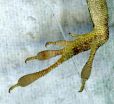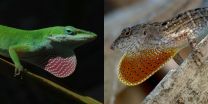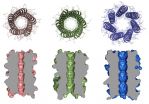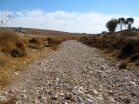(Press-News.org) Scientists working on islands in Florida have documented the rapid evolution of a native lizard species — in as little as 15 years — as a result of pressure from an invading lizard species, introduced from Cuba.
After contact with the invasive species, the native lizards began perching higher in trees, and, generation after generation, their feet evolved to become better at gripping the thinner, smoother branches found higher up.
The change occurred at an astonishing pace: Within a few months, native lizards had begun shifting to higher perches, and over the course of 15 years and 20 generations, their toe pads had become larger, with more sticky scales on their feet.
"We did predict that we'd see a change, but the degree and quickness with which they evolved was surprising," said Yoel Stuart, a postdoctoral researcher in the Department of Integrative Biology at The University of Texas at Austin and lead author of the study appearing in the Oct. 24 edition of the journal Science.
"To put this shift in perspective, if human height were evolving as fast as these lizards' toes, the height of an average American man would increase from about 5 foot 9 inches today to about 6 foot 4 inches within 20 generations — an increase that would make the average U.S. male the height of an NBA shooting guard," said Stuart. "Although humans live longer than lizards, this rate of change would still be rapid in evolutionary terms."
The native lizards studied, known as Carolina anoles or green anoles, are common in the southeastern U.S. The invasive species, Cuban anoles or brown anoles, are native to Cuba and the Bahamas. Brown anoles first appeared in South Florida in the 1950s, possibly as stowaways in agricultural shipments from Cuba, and have since spread across the southeastern U.S. and have even jumped to Hawaii.
This latest study is one of only a few well-documented examples of what evolutionary biologists call "character displacement," in which similar species competing with each other evolve differences to take advantage of different ecological niches. A classic example comes from the finches studied by Charles Darwin. Two species of finch in the Galápagos Islands diverged in beak shape as they adapted to different food sources.
The researchers speculate that the competition between brown and green anoles for the same food and space may be driving the adaptations of the green anoles. Stuart also noted that the adults of both species are known to eat the hatchlings of the other species.
"So it may be that if you're a hatchling, you need to move up into the trees quickly or you'll get eaten," said Stuart. "Maybe if you have bigger toe pads, you'll do that better than if you don't."
Stuart's co-authors are Todd Campbell at the University of Tampa; Paul Hohenlohe of the University of Idaho; Robert Reynolds of the University of Massachusetts, Boston; Liam Revell at the University of Massachusetts, Boston; and Jonathan Losos at Harvard University.
INFORMATION:
Support for this research was provided by the National Science Foundation, the National Institutes of Health, The University of Tennessee, Knoxville, and the Museum of Comparative Zoology at Harvard University.
When a solid material is immersed in a liquid, the liquid immediately next to its surface differs from that of the bulk liquid at the molecular level. This interfacial layer is critical to our understanding of a diverse set of phenomena from biology to materials science. When the solid surface is charged, just like an electrode in a working battery, it can drive further changes in the interfacial liquid. However, elucidating the molecular structure at the solid-liquid interface under these conditions has proven difficult.
Now, for the first time, researchers at the US ...
Ferns are believed to be 'old' plant species – some of them lived alongside the dinosaurs, over 200 million years ago. However, a group of Andean ferns evolved much more recently: their completely new form and structure (morphology) arose and diversified within the last 2 million years. This novel morphology seems to have been advantageous when colonising the extreme environment of the high Andes.
Dr Patricia Sanchez-Baracaldo (Bristol) and Dr Gavin Thomas (Sheffield) used molecular and morphological data to study a group of ferns which grow in a unique ecosystem ...
Proteins are long linear molecules that fold up to form well-defined 3D shapes. These 3D molecular architectures are essential for biological functions such as the elasticity of skin, the digestion of food, and the transport of oxygen in blood.
Despite the wide variety of tasks that natural proteins perform, they appear to use only a limited number of structural types, perhaps just a few thousand or so. These are used over and over again, being altered and embellished through evolution to generate many different functions. This raises the question: are more protein ...
A Dartmouth study suggests that it may be possible to use Diffuse Optical Spectroscopic Tomographic imaging (DOST) to predict which patients will best respond to chemotherapy used to shrink breast cancer tumors before surgery. These findings could eliminate delays in effective early treatment for tumors unlikely to respond to neoadjuvant chemotherapy (NAC). The study, "Predicting breast tumor response to neoadjuvant chemotherapy with Diffuse Optical Spectroscopic Tomography prior to treatment," was published online in Clinical Cancer Research on October 7, 2014.
Breast ...
BOSTON - New achievements in synthetic biology announced today by researchers at the Wyss Institute for Biologically Inspired Engineering, which will allow complex cellular recognition reactions to proceed outside of living cells, will dare scientists to dream big: there could one day be inexpensive, shippable and accurate test kits that use saliva or a drop of blood to identify specific disease or infection — a feat that could be accomplished anywhere in the world, within minutes and without laboratory support, just by using a pocket–sized paper diagnostic ...
(Santa Barbara, Calif.) — Volatile rainstorms drive complex landscape changes in deserts, particularly in dryland channels, which are shaped by flash flooding. Paradoxically, such desert streams have surprisingly simple topography with smooth, straight and symmetrical form that until now has defied explanation.
That paradox has been resolved in newly published research conducted by Michael Singer and Katerina Michaelides, associate researchers at UC Santa Barbara's Earth Research Institute. The pair show that simple topography in dryland channels is maintained ...
DALLAS – Oct. 23, 2014 – A hormone seen as a popular target to develop weight-loss drugs works by directly targeting the brain and triggering previously unknown activity in the nervous system, UT Southwestern Medical Center obesity researchers have found.
The fibroblast growth factor 21 (FGF21) hormone has been a key target for developing weight-loss drugs because the protein increases energy expenditure, causing the body to burn calories. But how the hormone worked wasn't known until now.
UT Southwestern researchers tracking the hormone discovered that ...
DENVER – Sixteen institutions across Europe collaborated together to show for the first time that a semi-quantitative anaplastic lymphoma kinase (ALK) protein expression test, immunohistochemistry (IHC), is reliable amongst several laboratories and reviewers when test methodology and result interpretation are strictly standardized and the scoring pathologists are appropriately trained on the test.
ALK tyrosine kinase inhibitors (TKIs) shrink tumors and increase progression-free survival in late-stage non-small cell lung cancer (NSCLC) patients positive for ALK as ...
DENVER –CANARY, Computer-Aided Nodule Assessment and Risk Yield, is a novel software tool developed at Mayo Clinic that can automatically quantitate adenocarcinoma pulmonary nodule characteristics from non-invasive high resolution computed tomography (HRCT) images and stratify non-small cell lung cancer (NSCLC) patients into risk groups that have significantly different disease-free survival outcomes.
The majority of NSCLC patients are diagnosed with advanced-stage disease which is concomitant with an exceptionally poor prognosis, 5-year survival rate of 4%. In ...
In individuals living in the Arctic, researchers have discovered a genetic variant that arose thousands of years ago and most likely provided an evolutionary advantage for processing high-fat diets or for surviving in a cold environment; however, the variant also seems to increase the risk of hypoglycemia, or low blood sugar, and infant mortality in today's northern populations. The findings, published online October 23 in Cell Press's American Journal of Human Genetics, provide an example of how an initially beneficial genetic change could be detrimental to future generations. ...





